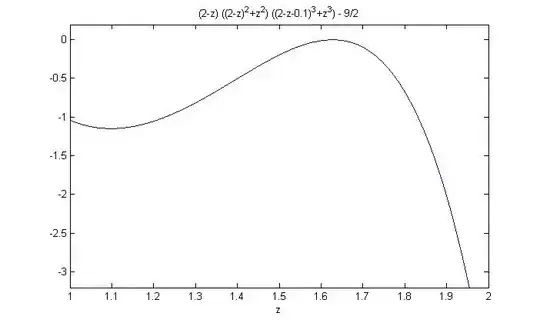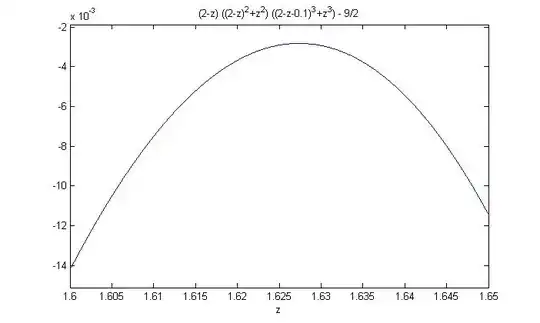Problem conditions allows us to eliminate the variable $x$ and to seek the unconditional maximal value of function
$$f(y,z)=(2-z)(y^2+z^2)(z^3+(2-y-z)^3).$$
Let $t=2-z,$ then
$$x=t-y,\quad z=2-t,$$
$$f(y,t)=(y^2t+t^3-4t^2+4t)((t-y)^3 + (2-t)^3),$$
$$0<y<t<2.\qquad (*)$$
Nesessary conditions of maximum within the area are
$$\begin{cases}
f'_y = 2yt\left((2-t)^3+(t-y)^3\right) + (y^2t+t^3-4t^2+4t)(-3)(t-y)^2 = 0\\
f'_t = (y^2+3t^2-8t+4)\left((2-t)^3+(t-y)^3\right) + (y^2t+t^3-4t^2+4t)(-3)\left((t-2)^2-(t-y)^2)\right) = 0
\end{cases}$$
$$\begin{cases}
2y\left((t-y)^3-(t-2)^3\right) -3(t-y)^2\left(y^2+(t-2)^2\right) = 0\\
(y^2+3t^2-8t+4)\left((t-y)^3-(t-2)^3\right)- 3t\left(y^2+2ty-4t+4)\right)\left(y^2+(t-2)^2\right) = 0
\end{cases}$$
This system is a homogeneous linear system for the variables $\left((t-y)^3-(t-2)^3\right)$ and $\left(y^2+(t-2)^2\right)$. The condition of existence of nonzero solutions of the form
$$\Delta=0,$$
$$\Delta=\begin{vmatrix}
2y & (t-y)^2\\
y^2+3t^2-8t+4 & t(-y^2+2ty-4t+4)
\end{vmatrix}$$
So
$$\begin{cases}
2yt(-y^2+2ty-4t+4) - (t-y)^2(y^2+3t^2-8t+4) = 0\\
2y\left((t-y)^3-(t-2)^3\right) -3(t-y)^2\left(y^2+(t-2)^2\right) = 0\\
\end{cases}.$$
As shown in attachment, the maximum value of the objective function among the extreme points reached when
$$(x,y,z,f)=(0.272109,0.066672,1.661219,4.311784),$$
or
$$(t,y,f)=(0.338781, 0.0666722, 4.31178).$$
It is easy to see that this point is a solution both the first and the second equations.
Verify the edges of area.
If $y=0$ then
$$f(t)=(t^3-4t^2+4t)(t^3+(2-t)^3) = 6t^5-36t^4+80t^3-80t^2+32t,$$
$$f'(t)=30t^4-144t^3+240t^2-160t+32 = 2(t-2)(15t^3-42t^2+36t-8).$$
Real root of $(15t^3-42t^2+36t-8)$ equals to
$$t_m=-\dfrac2{15}(-7+2^{1/3}+2 2^{2/3})\approx 0.34204,$$
$$f(t_m)=\dfrac{64 \left(376+92\cdot2^{1/3}+89\cdot2^{2/3}\right)}{9375}\approx4.32259.$$
(Updated)
If $t=y$ then
$$f(t) = (2t^3-4t^2+4t)(2-t)^3 = -2t^6 + 16t^5 - 52t^4 + 88t^3 - 80t^2 + 32t,$$
$$f'(t) = -12t^5 + 80t^4 - 208t^3 + 264t^2 - 160t + 32 = -4(t-2)^2(3t^3-8t^2+8t-2),$$
$$f(t)=\dfrac1{81}\left(-54t^3+288t^2-492t+260)(3t^3-8t^2+8t-2)+112t^2-472t+520\right)$$
Real root of $(3t^3-8t^2+8t-2)$ equals to
$$t_{m1}=\dfrac19\left(8-\dfrac8{\sqrt[3]{27\sqrt{17}-109}}+\sqrt[3]{27\sqrt{17}-109}\right)\approx0.364976,$$
$$f(t_{m1})=\dfrac1{81}\left(112{t_{m1}}^2-472t_{m1}+520\right)\approx4.47717$$
If $t=2$ that
$$f(y) = 2y^2(2-y)^3=-2y^5+12y^4-24y^3+16y^2,$$
$$f'(y) = -10y^4 + 48y^3 - 72y^2 + 32y = -2y(y-2)^2(5y-4),$$
$$(t,f) = \left(\dfrac45,\dfrac{6912}{3125}\right)\approx(0.8, 2.21184)$$
Account, that the values of function at the vertices of the area are zero.
Thus
$$f(y,t)<4.4772$$
and therefore
$$\boxed{(x+y)(y^2+z^2)(z^3+x^3)<\dfrac92\text{ for } x+y+z=2}$$
Completed 09.07.16
Attachment
The exact value of the maximum within the area defined by the system of two algebraic equations of the fourth order in two variables.
We show how to present its solution through the roots of a polynomial in one variable.
At first:
$$\begin{cases}
2ty(2-y)(2-2t+y) - (t-y)^2(y^2+(3t-2)(t-2)) = 0\\
y(2-y)(2(2-t)^2+(2y-2t)(2-2t+y)) - (t-y)^2(3y^2+(3t-6)(t-2)) = 0,
\end{cases}$$
$$\begin{cases}
2y(2-y)(-2t^2+(y+2)t) - (t-y)^2(3t^2-8t+4+y^2) = 0\\
y(2-y)((2-t)^2+(y-2t)(2-2t+y)) - (t-y)^2(y^2+2(2-t)) = 0.\quad [((2)-(1))/2]
\end{cases}$$
$$\begin{cases}
3(t-y)^4 + 2(3y-4)(t-y)^3 + 4(t-y)^2 - 2y(y-2)(3y-2)(t-y) - 2y^2(y-2)^2 = 0\\
(t-y)^3 - (3y^2-6y+2)(t-y)^2 + y(2-y)(3y-4)(t-y) + y(1-y)(2-y)^2 = 0,
\end{cases},$$
or
$$\begin{cases}
3x^4 + (6y-8)x^3 + 4x^2 - 2y(y-2)(3y-2)x - 2y^2(y-2)^2 = 0\\
x^3 - (3y^2-6y+2)x^2 + y(2-y)(3y-4)x + y(1-y)(2-y)^2 = 0,
\end{cases}.$$
Note that the first equation can be replaced for the remainder when divided by the second equation.
Given the identity of
$$(ax^2+bx)c^2 = (acx+bc-ad)(cx+d)+(ad-bc)d\qquad(1)$$
for
$$a=3,\quad b=6y-8,\quad c=1,\quad d=-(3y^2-6y+2),$$
the quotient of polynomials still $$q=3x+6y-8+3(3y^2-6y+2)=3x+9y^2-12y-2.$$
Therefore,
$$3x^4+(6y-8)x^3+4x^2-2y(y-2)(3y-2)x-2y^2(y-2)^2-(3x+9y^2-12y-2)(x^3-(3y^2-6y+2)x^2+y(2-y)(3y-4)x+y(1-y)(2-y)^2\\
= 3y(9y^3-27y^2+18y+4)x^2 + 3y(y-2)(9y^3-23y^2+9y+6)x + y(y-2)^2(9y^3-21y^2+8y+2).$$
Within the area $y\not=0,$ so we have
$$\begin{cases}
P_2(y)x^2 + 3(y-2)P_1(y)x + 3(y-2)^2P_0(y) = 0\\
x^3 - (3y^2-6y+2)x^2 + y(y-2)(4-3y)x+ y(1-y)(y-2)^2 = 0,
\end{cases}$$
where
$$P_0(y) = 9y^3-21y^2+8y+2,$$
$$P_1(y) = 3(9y^3-23y^2+9y+6),$$
$$P_2(y) = 3(9y^3-27y^2+18y+4).$$
Within the area $y\not=2.$
Let
$$x=(2-y)u,$$
then
$$\begin{cases}
P_2(y)u^2-P_1(y)u+P_0(y)=0,\\
(y-2)u^3 + (3y^2-6y+2)u^2 + (4y-3y^2)u + y^2-y = 0.
\end{cases}$$
Quotient by dividing of the second polynomial with multiplier $P_2^2$ to the second polynomial can be calculated by the formula $(1)$ for the values
$$a_1 = y-2,\quad b_1= 3y^2-6y+2,\quad c_1 = P_2(y),\quad d_1 = -P_1(y),$$
so it equals to
$$q_1(u,y) = (a_1u +b_1)c_1-a_1d_1 = ((y-2)u + 3y^2-6y+2)P_2(y)+(y-2)P_1(y),$$
$$q_1(u,y) = 3(u(y-2)(9y^3-27y^2+18y+4) + 27 y^5-126y^4+193y^3-95 y^2-4))$$
Wherein
$$P_2^2(y)\left((y-2)u^3 + (3y^2-6y+2)u^2 + (4y-3y^2)u + y^2-y)\right) - q_1(u,y)(P_2(y)u^2 - P_1(y)u + P_0(y))\\
= -3(81y^6-273y^5+132y^4+285y^3-94y^2-212y+56)u\\
+ 3(18y^6+3y^5-263y^4+518y^3-278y^2-16y+8).\\$$
So
$$\begin{cases}
P_2(y)u^2-P_1(y)u+P_0(y)=0,\\
Q_1(y)u-Q_0(y) = 0,\\
\end{cases}$$
where
$$Q_0(y) = 18y^6+3y^5-263y^4+518y^3-278y^2-16y+8,$$
$$Q_1(y) = 81y^6-273y^5+132y^4+285y^3-94y^2-212y+56.$$
At last, immediate using of $(1)$ gives
$$Q_1^2(P_2u^2-P_1u) = q_1(y,u)(Q_1u-Q_0)+(-P_2Q_0+P_1Q_1)(-Q_0),$$
so we have a system
$$\begin{cases}
P_2(y)Q_0^2(y)-P_1(y)Q_0(y)Q_1(y)+P_0(y)Q_1^2(y)=0,\\
Q_1(y)u-Q_0(y) = 0,\\
\end{cases}$$
where the first equation
$$28431y^{15}-332424y^{14}+1769283y^{13}-5834430y^{12}+13865013y^{11}
-25972002y^{10}+39273849y^9-46208412y^8+39498804y^7-22289616y^6+6739136y^5-82304y^4-544960y^3+77312y^2+12544y-1024=0$$
depends only on the $y$ and for $y\in(0,2)$ has roots
$$y_4=0.06667216, y_5=0.36405184, y_8=1.26087211, y_9=1.53077106, y_{12}=1.65191401,$$
full Mathcad results are:

That gives us the next solutions within the area $x,y,z>0:$
$$(x,y,z,f)\in\left\{
\begin{matrix}
(0.272109,0.066672,1.661219,4.311784)\\
(1.217651,0.364052,0.418297,0.913705)\\
(0.229352,1.530771,0.239877,0.109307)\\
(0.164858,1.651914,0.183228,0.053358)
\end{matrix}
\right\}$$
Done!
It can be seen that using the algorithm for polynomials, similar the Euclidean algorithm, eliminates the second variable $x$ (or $u$), expressing it through the ratio of polynomials.
Also it gives a polynomial equation for $y$.




